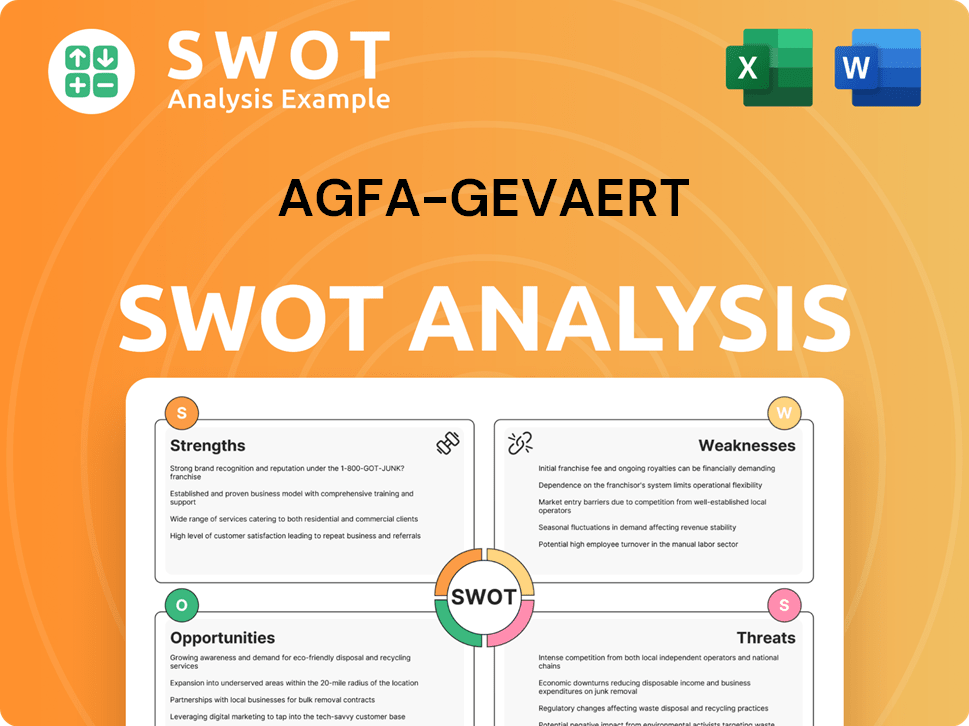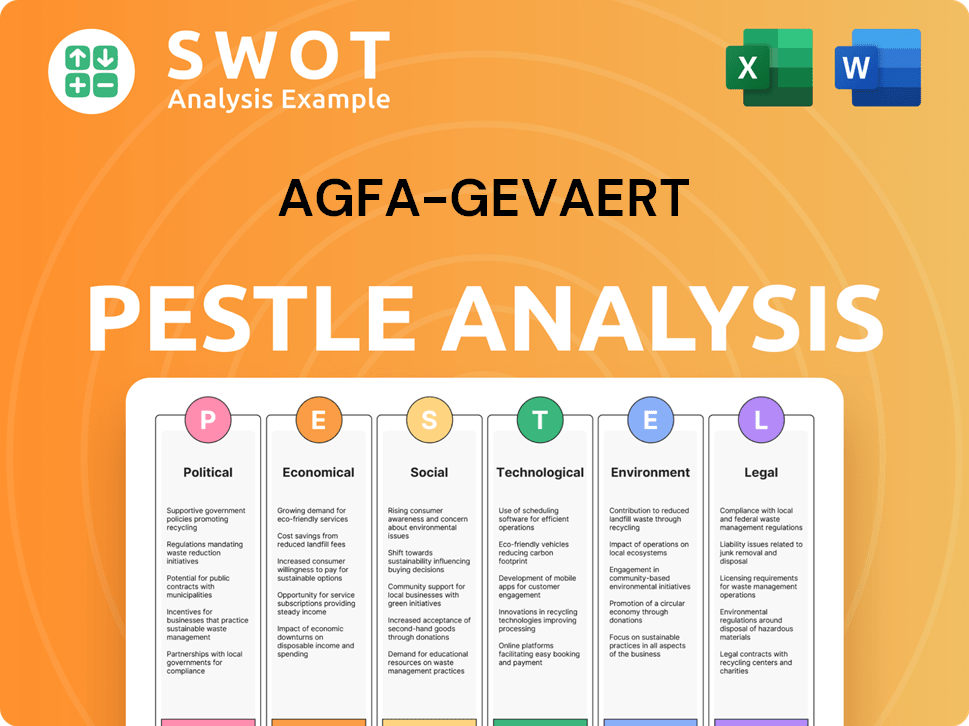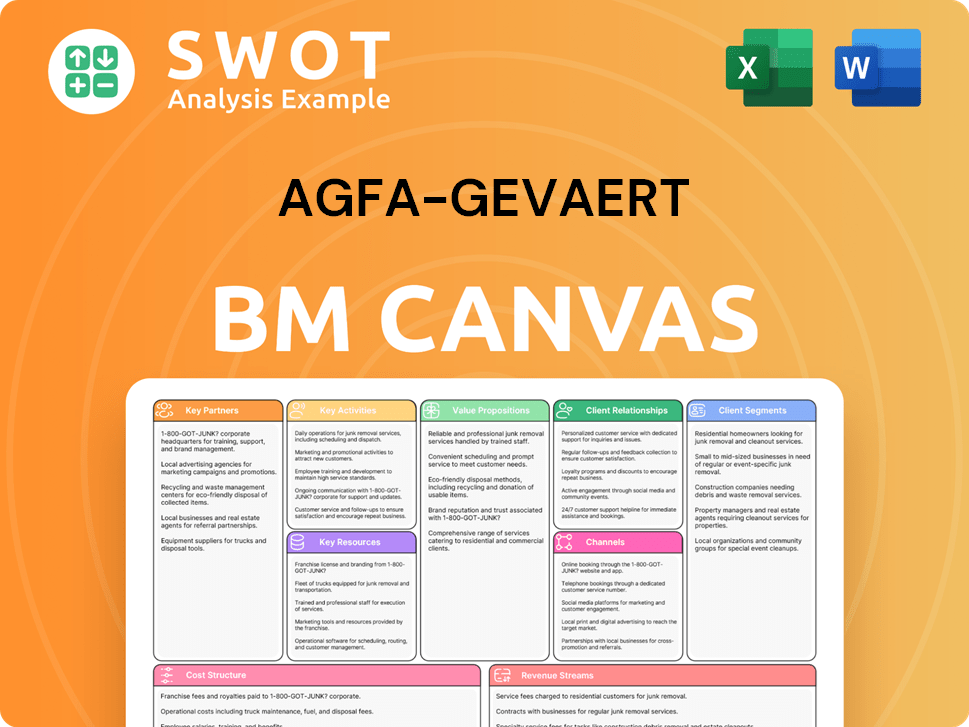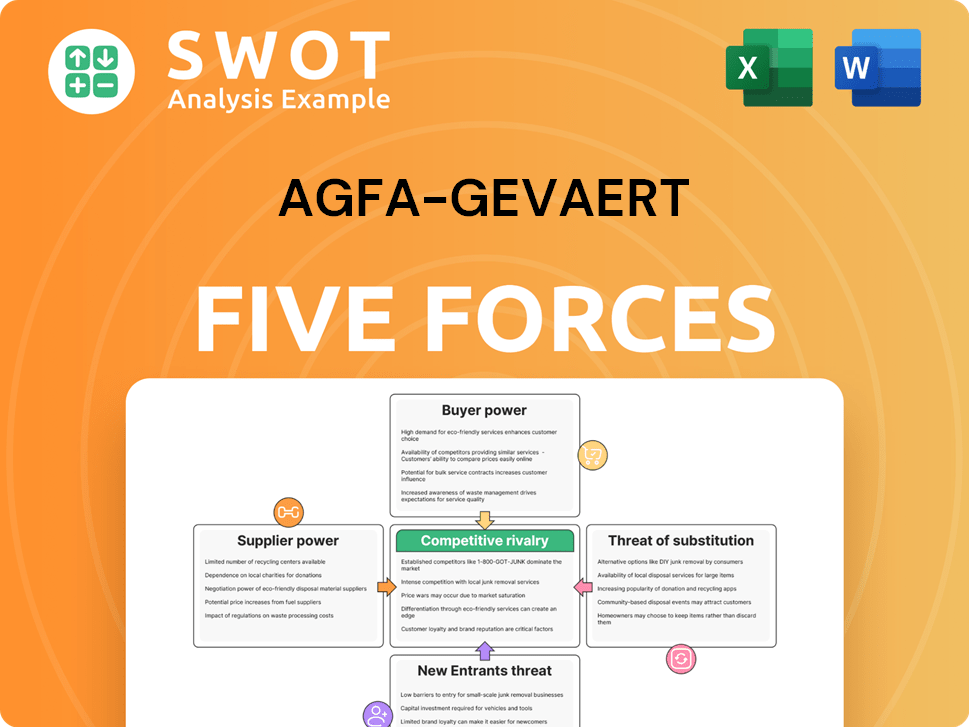Agfa-Gevaert Bundle
How has Agfa-Gevaert shaped the world of imaging?
Journey back in time to explore the fascinating story of Agfa-Gevaert, a company that has indelibly marked the history of photography and technology. From its humble beginnings in 1867 as a chemical manufacturer, this Agfa-Gevaert SWOT Analysis showcases its strategic evolution. Discover how this Belgian company and its innovations have transformed image capture, printing, and healthcare, leaving a lasting legacy.

The Agfa history is a compelling narrative of innovation and adaptation, from film manufacturing to digital solutions. Learn about the early days of Gevaert and its pivotal role in the photographic industry. This exploration of the Gevaert company will illuminate its strategic shifts, key milestones, and enduring impact on the world, providing insights into its resilience and future prospects.
What is the Agfa-Gevaert Founding Story?
The story of Agfa-Gevaert is a tale of two companies, Agfa and Gevaert, merging to become a significant player in the imaging industry. This Photography company, born from the union of German and Belgian enterprises, left a lasting impact on the world of photography and film manufacturing. Understanding the Agfa history and Gevaert company background provides valuable insight into the evolution of imaging technology.
The journey of Agfa-Gevaert began with the individual successes of its founding companies. Each company carved a niche in the rapidly evolving landscape of the late 19th and early 20th centuries. Their eventual merger created a powerhouse, shaping the future of photographic materials and technologies.
Let's explore the brief history of Agfa and Gevaert to understand the origins of Agfa-Gevaert.
Agfa (Actien-Gesellschaft für Anilin-Fabrikation) was established on July 21, 1867, in Rummelsburg, Berlin, Germany. The founders, Paul Mendelssohn Bartholdy and Carl Alexander von Martius, were chemists who focused on producing dyes for the textile industry. This strategic move capitalized on the growing demand for synthetic dyes.
- Agfa's initial focus was on the production of dyes for the textile industry.
- The company aimed to meet the increasing demand for synthetic dyes.
Lieven Gevaert founded the Gevaert company in Antwerp, Belgium, in 1890. Gevaert's primary focus was on producing photographic paper, recognizing the rising popularity of photography. The company targeted both amateur and professional photographers.
- Gevaert was founded in Antwerp, Belgium, in 1890.
- The company specialized in producing photographic paper.
- Gevaert catered to the needs of amateur and professional photographers.
Both Agfa and Gevaert initially manufactured chemical-based products for their respective markets. Agfa's early funding came from initial capital investments from its founders and early shareholders. Gevaert's early operations were likely bootstrapped or funded through initial investments from family and friends.
- Agfa's funding came from initial capital investments.
- Gevaert's early operations were likely bootstrapped.
The merger of Agfa and Gevaert in 1964 created Agfa-Gevaert. This merger combined their expertise in photographic chemicals and materials. The consolidation trend in the photographic and chemical industries influenced this merger.
- The merger occurred in 1964.
- It combined expertise in photographic chemicals and materials.
- The merger was influenced by industry consolidation.
Agfa-Gevaert SWOT Analysis
- Complete SWOT Breakdown
- Fully Customizable
- Editable in Excel & Word
- Professional Formatting
- Investor-Ready Format

What Drove the Early Growth of Agfa-Gevaert?
The early growth of Agfa, after its 1867 founding, was propelled by the rising demand for synthetic dyes, establishing it as a key player in the chemical sector. The company's strategic diversification into photographic products marked a pivotal shift, leveraging its chemical expertise. This expansion included the production of photographic plates, films, and cameras, which was a significant step into the imaging market. This period set the stage for its future in the photographic industry.
Gevaert, founded in 1890, initially concentrated on photographic paper, broadening its product range to encompass films. This expansion capitalized on the growing photography market, particularly in Europe. This focus allowed Gevaert to establish itself as a reputable name in the photography company.
During World War II, Agfa, under IG Farben's ownership, continued research and development in photographic materials. Post-war, Agfa regained independence and increased its focus on consumer photography and professional imaging. Gevaert also experienced steady growth as a Belgian company, solidifying its reputation in the photographic sector.
The 1964 merger of Agfa and Gevaert created Agfa-Gevaert. This strategic move consolidated resources, expanded market reach, and enhanced competitiveness against larger international rivals. The newly formed entity immediately strengthened its presence in both European and global markets, marking a significant milestone in Agfa history.
Following the merger, Agfa-Gevaert broadened its product portfolio and geographical presence. Key developments included innovative photographic films and papers, and a shift towards digital imaging technologies. The company entered new markets, such as medical imaging, leveraging its image processing expertise. In 1996, Agfa acquired the DuPont Printing & Publishing business, expanding its presence in the graphic arts sector.
Agfa-Gevaert PESTLE Analysis
- Covers All 6 PESTLE Categories
- No Research Needed – Save Hours of Work
- Built by Experts, Trusted by Consultants
- Instant Download, Ready to Use
- 100% Editable, Fully Customizable

What are the key Milestones in Agfa-Gevaert history?
The story of Agfa-Gevaert, a prominent Belgian company, is marked by significant achievements and transformations. From its early days as a photography company to its evolution in the digital age, the Agfa history showcases a journey of innovation and adaptation. The Gevaert company played a crucial role in shaping the photographic industry, and the merger of these two entities created a formidable force.
| Year | Milestone |
|---|---|
| Early 20th Century | Agfa introduces Agfacolor, a pioneering color film technology. |
| 1964 | Merger of Agfa and Gevaert, creating a major player in photographic materials. |
| Late 20th Century | Agfa-Gevaert becomes a key supplier of X-ray film technology in the medical field. |
| 2004 | Divestiture of the consumer imaging division to focus on other sectors. |
| 21st Century | Expansion into digital printing solutions and healthcare IT, including advanced radiography systems. |
Agfa-Gevaert has consistently pushed the boundaries of imaging technology. The company's advancements in film manufacturing and the development of innovative products like Agfacolor significantly impacted the photographic industry. Their ventures into medical imaging, including computed radiography (CR) and direct radiography (DR) systems, showcase their commitment to innovation.
Agfa's introduction of Agfacolor revolutionized color photography, making it accessible to a wider audience. This innovation allowed for more vibrant and realistic images, transforming how people captured memories.
Agfa-Gevaert made significant contributions to medical imaging with its X-ray film technology. This technology became essential for hospitals worldwide, improving diagnostic capabilities.
The company's development of advanced computed radiography (CR) and direct radiography (DR) systems marked a shift towards digital imaging in healthcare. These systems improved the efficiency and quality of medical image acquisition and management.
Agfa-Gevaert expanded its offerings with comprehensive hospital information systems (HIS). These systems streamlined hospital workflows and improved patient care.
The development of picture archiving and communication systems (PACS) enhanced the storage and management of medical images. This innovation improved access and collaboration for healthcare professionals.
Agfa-Gevaert expanded into digital printing solutions for the graphic arts industry. This move demonstrated the company's ability to adapt to changing market demands.
Agfa-Gevaert faced considerable challenges, especially with the rise of digital imaging. The decline of the analog photography market significantly impacted their core business. The company had to navigate competitive pressures and rapid technological changes, requiring strategic pivots and restructuring. Learn more about the Target Market of Agfa-Gevaert.
The shift from analog to digital imaging posed a major challenge, impacting the core photographic film business. This transition necessitated significant strategic adjustments to remain competitive.
The decline in the analog photography market led to a significant downturn, affecting revenue and necessitating restructuring. This required difficult decisions regarding workforce and asset management.
New digital players and rapid technological advancements increased competition. Agfa-Gevaert needed to continuously innovate to stay relevant in the market.
The company undertook significant restructuring efforts, including the divestiture of the consumer imaging division in 2004. These efforts aimed to streamline operations and focus on more promising sectors.
Navigating the transition required difficult decisions, including workforce reductions and asset sales. The company faced internal challenges during this period of change.
The rapidly evolving digital markets required Agfa-Gevaert to continuously innovate. This commitment to R&D was crucial for long-term success.
Agfa-Gevaert Business Model Canvas
- Complete 9-Block Business Model Canvas
- Effortlessly Communicate Your Business Strategy
- Investor-Ready BMC Format
- 100% Editable and Customizable
- Clear and Structured Layout

What is the Timeline of Key Events for Agfa-Gevaert?
The journey of Agfa-Gevaert, a prominent player in the imaging industry, is marked by significant milestones. From its origins in the late 19th century, the company has evolved through mergers, technological advancements, and strategic shifts to adapt to the changing landscape of photography and healthcare. This evolution has seen the company navigate from film manufacturing to digital imaging solutions, expanding its presence in both healthcare and digital printing sectors.
| Year | Key Event |
|---|---|
| 1867 | Agfa (Actien-Gesellschaft für Anilin-Fabrikation) was established in Berlin, Germany, initially focusing on dye production. |
| 1890 | Gevaert was founded in Antwerp, Belgium, specializing in photographic paper. |
| Early 1900s | Agfa expanded into photographic materials, including films and cameras. |
| 1932 | Agfa introduced Agfacolor Neu, a pioneering subtractive color film. |
| 1964 | Agfa and Gevaert merged to form Agfa-Gevaert, consolidating their positions in the imaging market. |
| 1970s-1980s | The company expanded in medical imaging with advanced X-ray film technologies. |
| 1990s | Significant investment was made in digital imaging technologies and solutions. |
| 1996 | The acquisition of DuPont Printing & Publishing business expanded graphic arts presence. |
| 2004 | The consumer imaging business was divested to adapt to the digital photography shift. |
| 2005 onwards | Strategic focus shifted to healthcare IT, digital radiology, and industrial inkjet printing. |
| 2019 | Agfa-Gevaert announced a strategic transformation program to enhance profitability and focus on growth engines. |
| 2023 | Continued focus on R&D in digital printing and healthcare IT, with new product introductions in both segments. |
| 2024 | Agfa-Gevaert continues to streamline its operations and invest in sustainable solutions across its divisions, with an emphasis on green chemistry in its Digital Print & Chemicals segment and energy-efficient solutions in healthcare. |
| 2025 | Projections indicate continued growth in specific digital print applications and further expansion of its healthcare IT solutions, leveraging AI and cloud technologies. |
Agfa-Gevaert is focusing on expanding its enterprise imaging platform. This includes integrating AI-powered analytics and cloud-based solutions to improve clinical workflows and data management. The global medical imaging market is anticipated to grow at a CAGR of over 6% from 2024 to 2029, indicating a significant growth opportunity.
The company is investing in industrial inkjet solutions, targeting high-growth applications such as packaging and industrial decoration. The digital printing market is projected to reach approximately $37 billion by 2028. This represents a CAGR of 5.5% from 2023, highlighting the potential for expansion in this segment.
Agfa-Gevaert emphasizes innovation, sustainability, and customer-centricity as key drivers for future growth. The company aims to achieve sustainable profitability and generate cash flow to invest in its growth engines. This approach aligns with the evolving demands of the market for eco-friendly solutions.
The company's forward-looking strategy is centered on strengthening core businesses in digital print and healthcare IT. This strategic direction builds on the company's legacy of providing advanced imaging solutions, now adapted for a digital world. The company is focusing on leveraging AI and cloud technologies to enhance its products and services.
Agfa-Gevaert Porter's Five Forces Analysis
- Covers All 5 Competitive Forces in Detail
- Structured for Consultants, Students, and Founders
- 100% Editable in Microsoft Word & Excel
- Instant Digital Download – Use Immediately
- Compatible with Mac & PC – Fully Unlocked

Related Blogs
- What is Competitive Landscape of Agfa-Gevaert Company?
- What is Growth Strategy and Future Prospects of Agfa-Gevaert Company?
- How Does Agfa-Gevaert Company Work?
- What is Sales and Marketing Strategy of Agfa-Gevaert Company?
- What is Brief History of Agfa-Gevaert Company?
- Who Owns Agfa-Gevaert Company?
- What is Customer Demographics and Target Market of Agfa-Gevaert Company?
Disclaimer
All information, articles, and product details provided on this website are for general informational and educational purposes only. We do not claim any ownership over, nor do we intend to infringe upon, any trademarks, copyrights, logos, brand names, or other intellectual property mentioned or depicted on this site. Such intellectual property remains the property of its respective owners, and any references here are made solely for identification or informational purposes, without implying any affiliation, endorsement, or partnership.
We make no representations or warranties, express or implied, regarding the accuracy, completeness, or suitability of any content or products presented. Nothing on this website should be construed as legal, tax, investment, financial, medical, or other professional advice. In addition, no part of this site—including articles or product references—constitutes a solicitation, recommendation, endorsement, advertisement, or offer to buy or sell any securities, franchises, or other financial instruments, particularly in jurisdictions where such activity would be unlawful.
All content is of a general nature and may not address the specific circumstances of any individual or entity. It is not a substitute for professional advice or services. Any actions you take based on the information provided here are strictly at your own risk. You accept full responsibility for any decisions or outcomes arising from your use of this website and agree to release us from any liability in connection with your use of, or reliance upon, the content or products found herein.